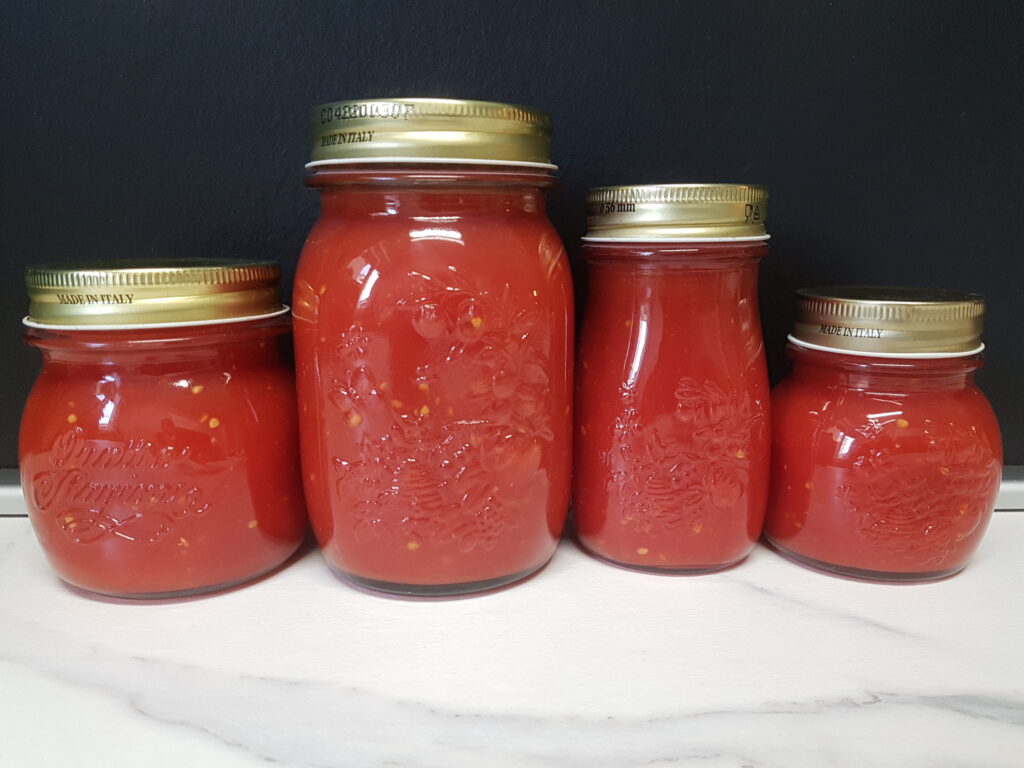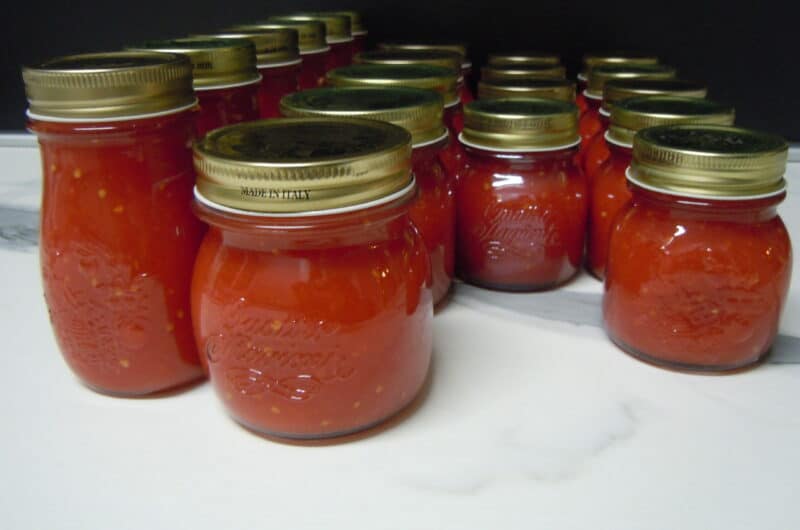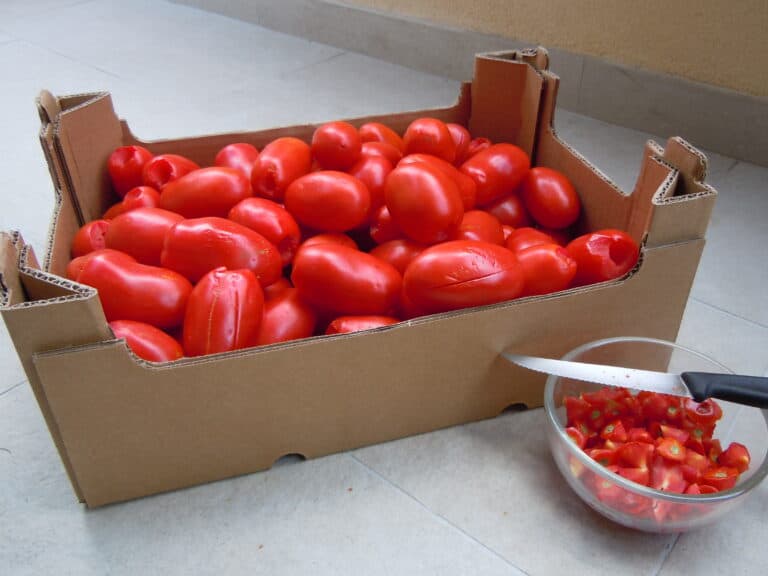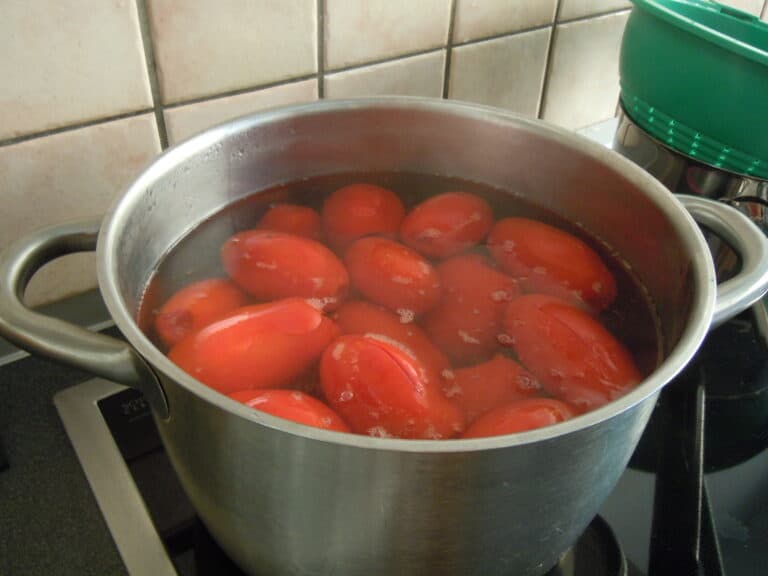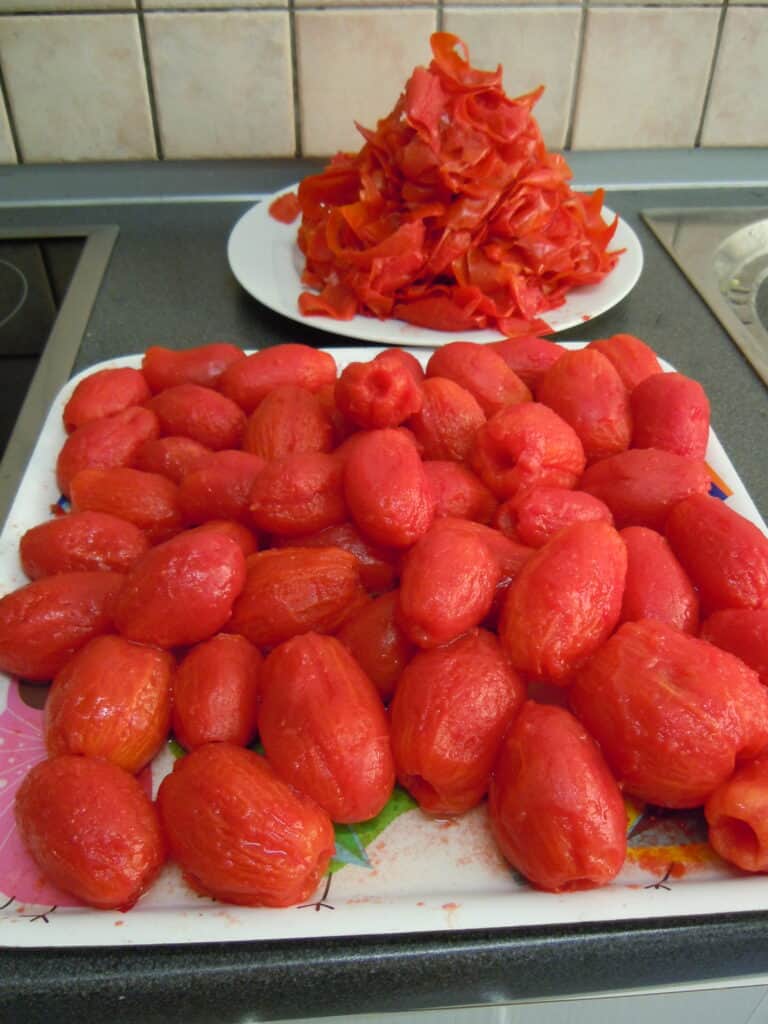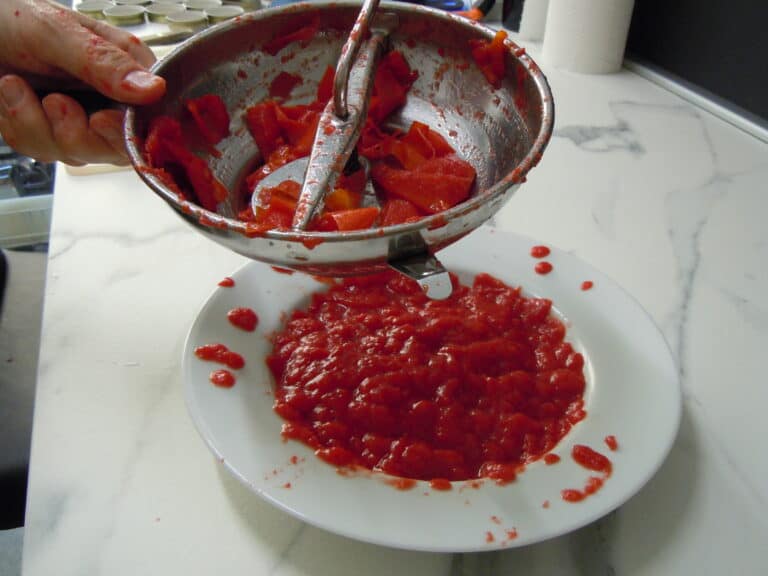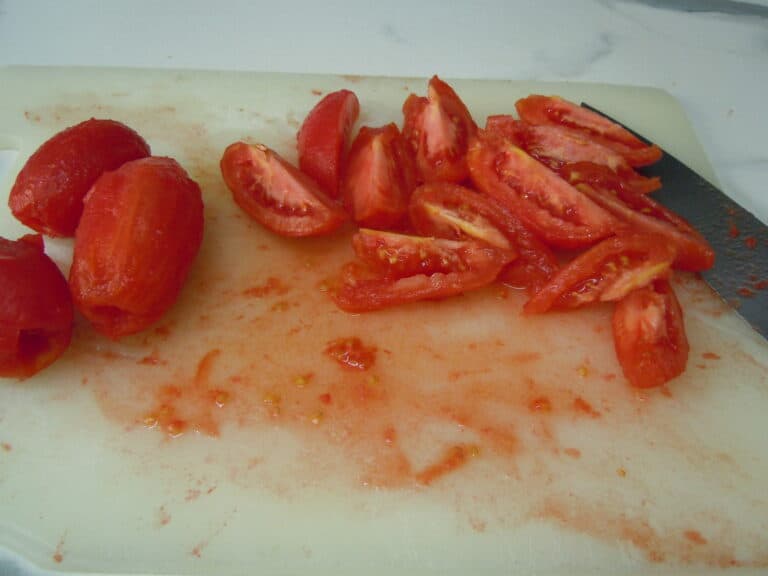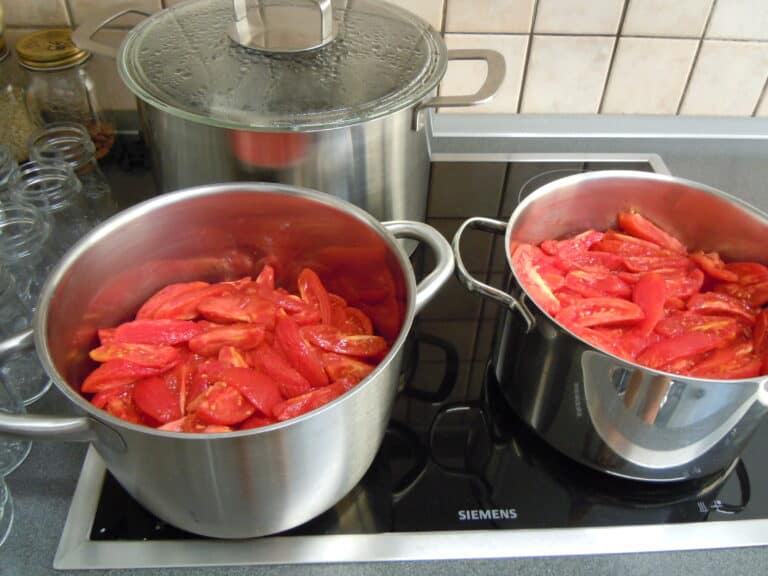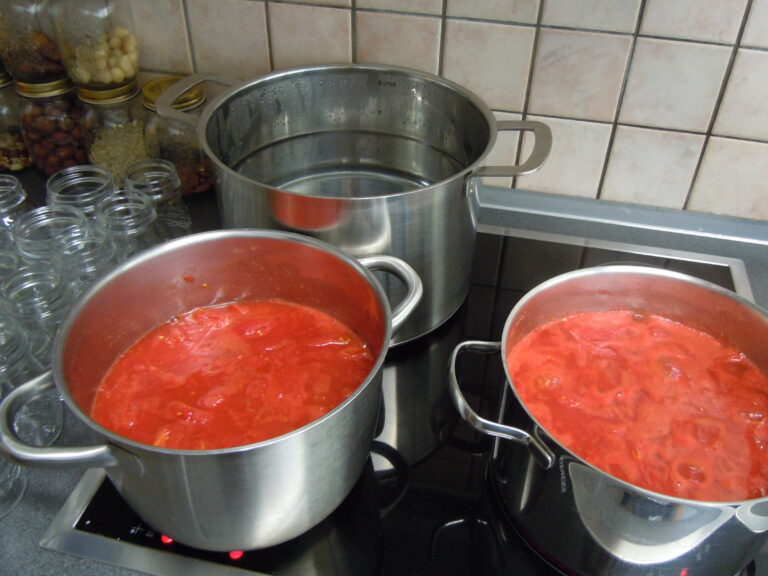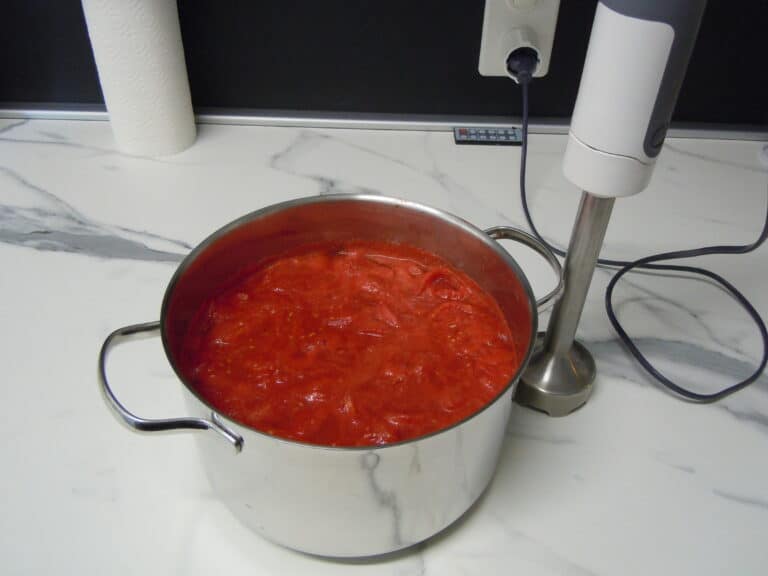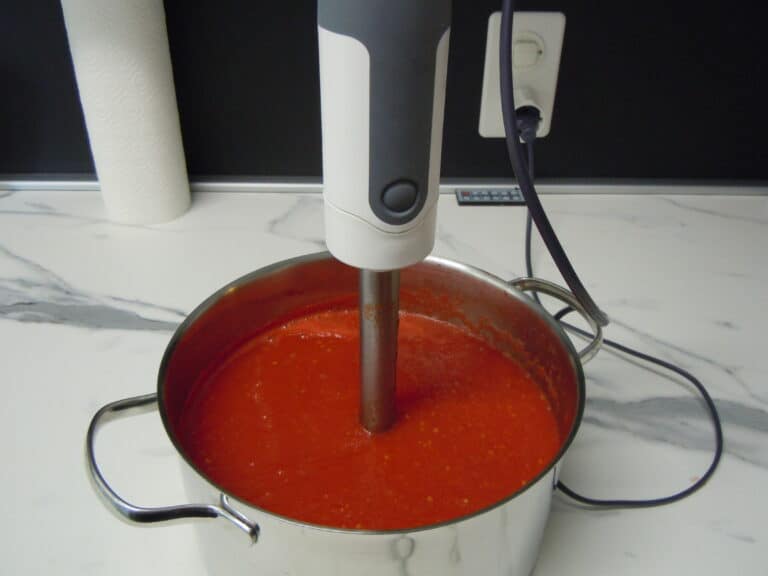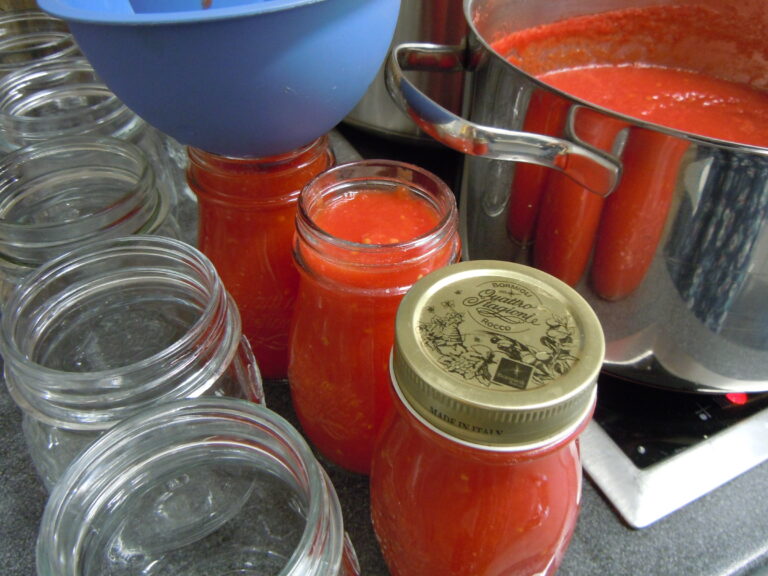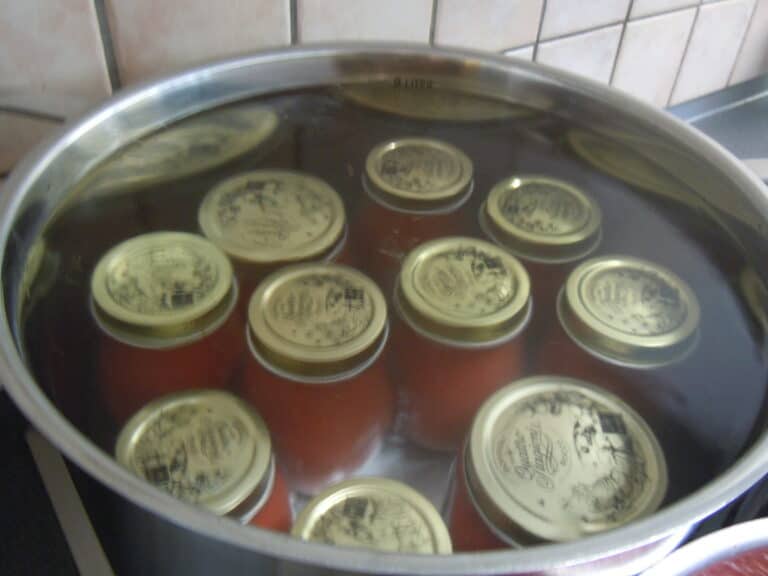This is the perfect time to make and jar your own homemade tomato sauce! In August, tomatoes are cheap and abundant. They are ripe, juicy and bursting with flavour. Just waiting to be transformed into a succulent summer tomato-based dish, like gazpacho, Greek salad and pasta with homemade tomato sauce. It makes you want to preserve that flavour for the rest of the year! And you can! Just follow my step-by-step guide, and you’ll be able to enjoy the flavour of summer tomatoes all year round! Take advantage of this opportunity to ensure you have a stash to last you through the winter.
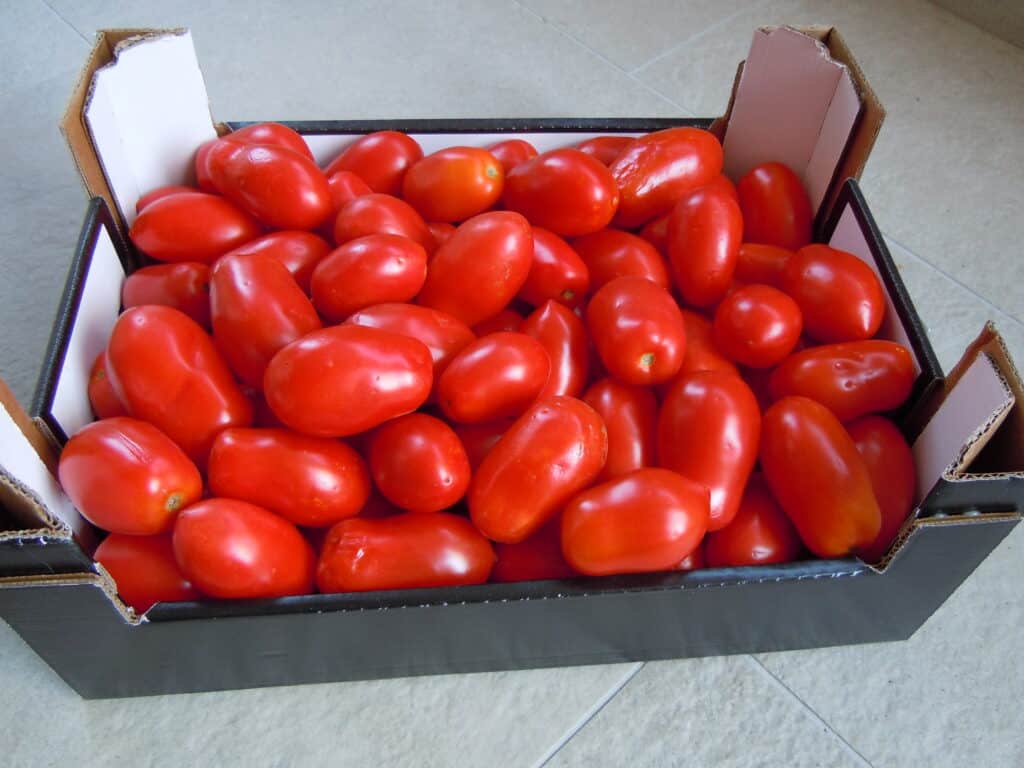
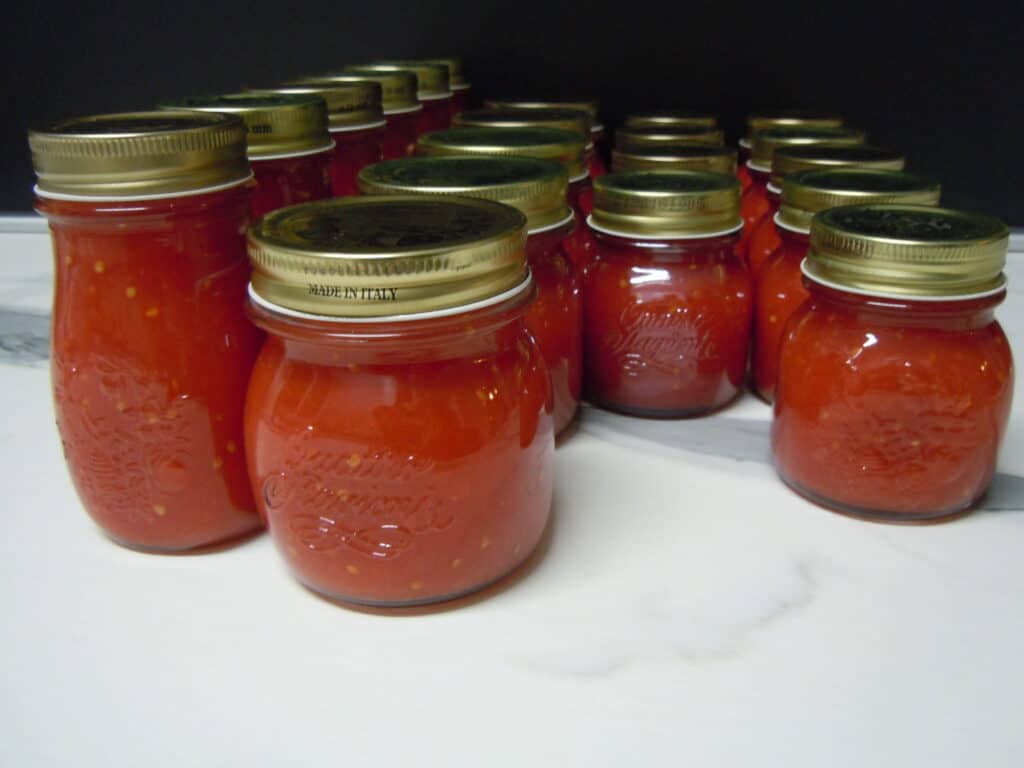
- Introduction – The Italian way of making and jarring tomato sauce
- What equipment do you need for jarring tomato sauce?
- Important notes
- What kind of jars do you need for homemade tomato sauce?
- Hygiene
- How to clean the lids
- How to sterilise the jars
- How to make homemade tomato sauce
- How to process the tomato sauce using a boiling hot water bath
- How to check the seals
- Storage
- How long will the jars of tomato sauce last?
- Final precautions
Introduction – The Italian way of making and jarring tomato sauce
This is the Italian way of making tomato sauce, and it’s traditional in households all over Italy to make it every summer. Below you’ll all the necessary steps and precautions on how to make the sauce and preserve it in jars so that you can still enjoy the taste of those juicy summer tomatoes long after the season is over. There is only one ingredient in the sauce: tomatoes.
There are several reasons for not adding other ingredients such as salt, oil and herbs. Salt shortens the shelf life. Oil increases the risk of botulinum poisoning. Lemon juice is unnecessary and spoils the flavour of the sauce. It’s very common in the US to add lemon juice to increase acidity. Italians don’t use lemon juice.
Salt, oil and herbs are best added when you reopen the jar to use the sauce. That way you’ll have a neutral sauce that you can flavour to your liking according to the dish you’re making. You don’t want to be stuck with a basil-flavoured tomato sauce if you’re making chili con carne or an Indian curry!

What equipment do you need for jarring tomato sauce?
For jarring the tomato sauce, you’ll need the following equipment:
- A large deep saucepan for the boiling hot water bath, which is deep enough to completely submerge the jars, with another couple of centimetres of water above the tops.
- A rack that fits inside the saucepan (optional). Some glass jars may crack if they come into contact with the direct heat at the bottom of the pan. The rack keeps the jars elevated. This has never happened to me, so I don’t use a rack.
- Jars which have been specifically manufactured for boiling hot water jarring processes (see below).
- Single-use lids that fit your jars. You must use brand-new lids every time you jar food. These lids have a special lining inside that softens during the boiling process, allowing air to escape from the jar during cooling, forming an airtight seal as the jars cool.
- A funnel – Ideally stainless steel, otherwise plastic. It should have a wide mouth for easy filling. A funnel prevents the tomato sauce from spilling onto the rim and down the sides of the jar while you’re filling it.
- A stainless-steel ladle to pour the sauce into the jars through the funnel. A soup ladle will work well but if you’re buying a new one, go for a long-handled model with a pouring spout or rim.
- A jar lifter. These are specialized tongs that fit around the base of the jar rims to safely lift the jars in and out of the saucepan.
- An immersion blender to blend the sauce.
- A food mill/vegetable mouli or a strainer to remove skins and seeds from the pulp.
- A sieve to filter the seeds out (optional) I don’t filter out the seeds, Italian San Marzano tomatoes don’t have many seeds.
- A couple of large saucepans to cook the tomatoes in.
- A clean chopping board.
- A sharp knife.
- Clean kitchen tea towels
Important notes
Only use an electric or gas cooker for processing tomato sauce. It’s not safe to jar tomato sauce using any other method, nor is it safe to jar tomato sauce by simply sterilising the jars and then ladling boiling-hot sauce into the jars, and sealing them by screwing the lid on. Even if the jars hold their seal, their contents have NOT been heated adequately to prevent bacteria, toxins, moulds and yeast to grow when the jars are stored at room temperature.
Some new-generation multi-cookers come with a jarring feature, these devices are not always safe for jarring tomato sauce or any other kind of food. It’s best to be prudent and only use tried-and-tested methods of jarring/canning that have been safely used for decades.
What kind of jars do you need for homemade tomato sauce?
You MUST use jars which have been specifically designed for use in boiling hot water jarring processes. I use Bormioli Rocco Quattro Stagioni jars which are easy to find in Italy and Switzerland. They come in many sizes, but the most useful for jarring tomato sauce are 150 ml, 250 ml and 500 ml (approx. 1, 2 and 4 portions respectively). There are several other makes on the market, like Ball and Kilner. I would advise against using anything larger than 500 ml in a domestic environment. One reason is that you’ll need an enormous pan to keep a litre jar submerged. Secondly, you might not need a litre of sauce for one meal, meaning you’ll have sauce left over that you need to store in the fridge. Most domestic fridges don’t have much space for such a large jar.
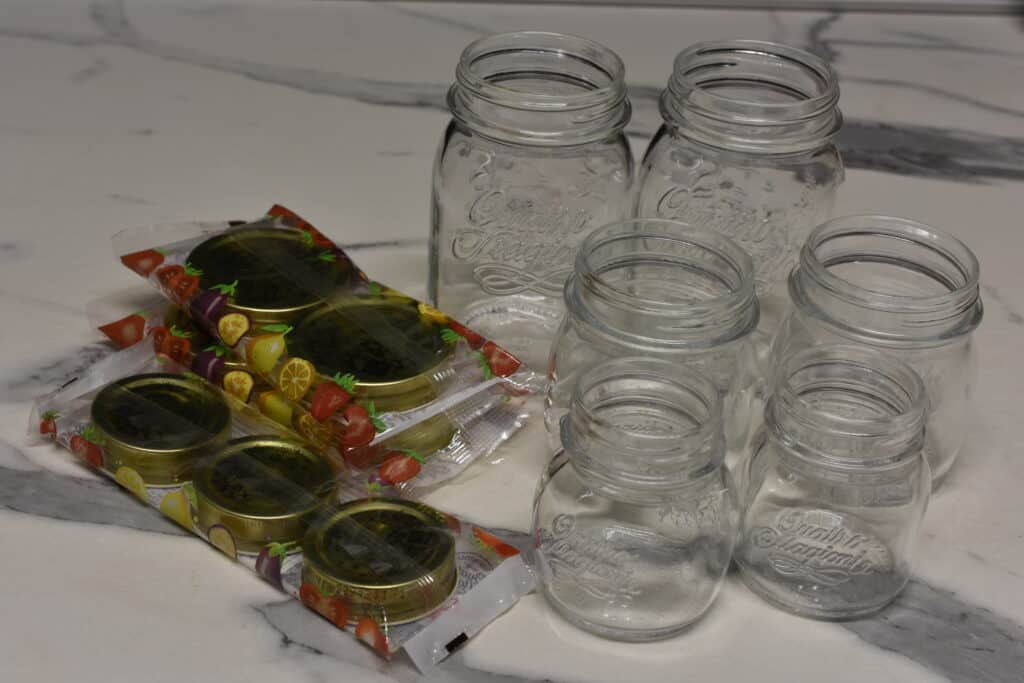
Hygiene
Make sure that all your equipment, kitchen gadgets, knives, chopping boards, work surfaces, etc are scrupulously clean. Hair should be tied up, hands clean and nails preferably short and manicured.
How to clean the lids
Prepare the lids before the jars. Theoretically, there is no need to clean them as they are packed in a sterile environment. However, manufacturers recommend rinsing them by hand, without dish soap, in hot water. The lids are not dishwasher safe and you should not boil them before first use. This is because the inside rim of the lid has a special lining, which acts as a seal. Lids are intended for single use only, and that includes boiling. When you have rinsed them, put the lids on a clean tea towel with the rims facing downwards. That way, there’s no risk of anything falling into the lids and contaminating them while you are working.
How to sterilise the jars
Sterilising the jars is something you will need to do shortly before you jar your tomato sauce.
- Wash the jars with warm soapy water
- Place the jars in the saucepan you intend to use for the boiling hot water bath, with the rim facing upwards.
- Fill the pan with hot water, place it on the stove and bring the water to a boil.
- Boil the jars for 10 minutes.
- Using the jar lifter, remove the jars from the pan, drain the water out and place them on a clean tea towel with the rim facing upwards. That way, they will steam dry within a minute or so. Do NOT place the boiling hot jars onto a cold surface, as this may cause them to crack.
- The time lapse between sterilising the jars and filling them should be as short as possible. Therefore, as soon as you have finished sterilising the jars, you should be ready to fill them with the tomato sauce.
Read about Bormioli Rocco‘s recommended jar sterilisation procedure here.
How to make homemade tomato sauce
Ingredients
Italian plum tomatoes (or other variety of your choice).

Buy a crate or crates of good, ripe tomatoes. I usually choose Italian plum tomatoes for several reasons: they are the classic choice for jarring, bottling and canning; they contain few seeds and little water; they are cheap, readily available and abundant in August. In my allotment, I grow San Marzano tomatoes, and there’s something incredibly satisfying about making tomato sauce with your own homegrown tomatoes!
I usually do one or two crates at a time. That’s about as much as I can take on in a day – from start to finish a couple of crates (12 kg) will take me about 5 hours if I’m on my own, half that if I get some help. If you have the equipment and some manpower, you could easily double or triple the production.
This recipe is for 6 kg of tomatoes which will yield approx. 3 – 4 litres of tomato sauce.
Method
In the recipe card at the end of this post, you’ll find step-by-step instructions with photos.
How to prepare the tomatoes
- Trim or discard any tomatoes that have imperfections, mould, or are starting to rot.
- Wash the tomatoes. Using a sharp knife, remove the hard part of the core and make a long slit in the skin of each tomato.
- In batches, plunge the tomatoes into a pan of boiling water to loosen the skins. Leave them submerged in the boiling water for 1 – 2 minutes.
- Using a slotted spoon, remove the tomatoes from the pan and plunge them into very cold water. The thermal shock will make the skins easy to remove.
- Peel the skins off the tomatoes.
- Put the skins through a vegetable mouli in order to extract the pulp left on them.
- Cut the skinned tomatoes into quarters or into chunks.
Make the tomato sauce
- Put the tomato quarters or chunks into saucepans. Add the pulp you extracted with the mouli. The saucepans should be no more than 3/4 full.
- Turn the heat on low and slowly bring the tomatoes to a boil. Don’t use a lid and don’t add any water. The tomatoes will cook in their own juice. Stir often, especially in the beginning. If you burn the sauce on the bottom of the pan, you’ll risk ruining the whole lot. If it does happen, don’t stir the sauce! Immediately ladle it out into a clean saucepan, discarding the burnt part at the bottom of the pan.
- Once the tomatoes have come to a boil, turn the heat down and simmer for 30 – 45 minutes.
- Using an immersion blender, blend the tomatoes to the desired consistency. I usually blend mine until quite smooth because I use it for tomato-based pasta sauces, as well as pizza and other dishes. So a thin passata is usually the most versatile type of tomato sauce to have on hand.
- Use a sieve to filter out the seeds if you want. Sometimes I make a few jars of more rustic tomato sauce, with chunks in it, that I use for other dishes where I want more texture.
- If the sauce is the right consistency, you can go ahead and jar it. If it’s too thin, return the pan to a low heat and simmer it for a bit longer – this will reduce it. I prefer not to reduce mine too much because it will reduce further when I add it to onions and garlic etc to make other tomato-based sauces.
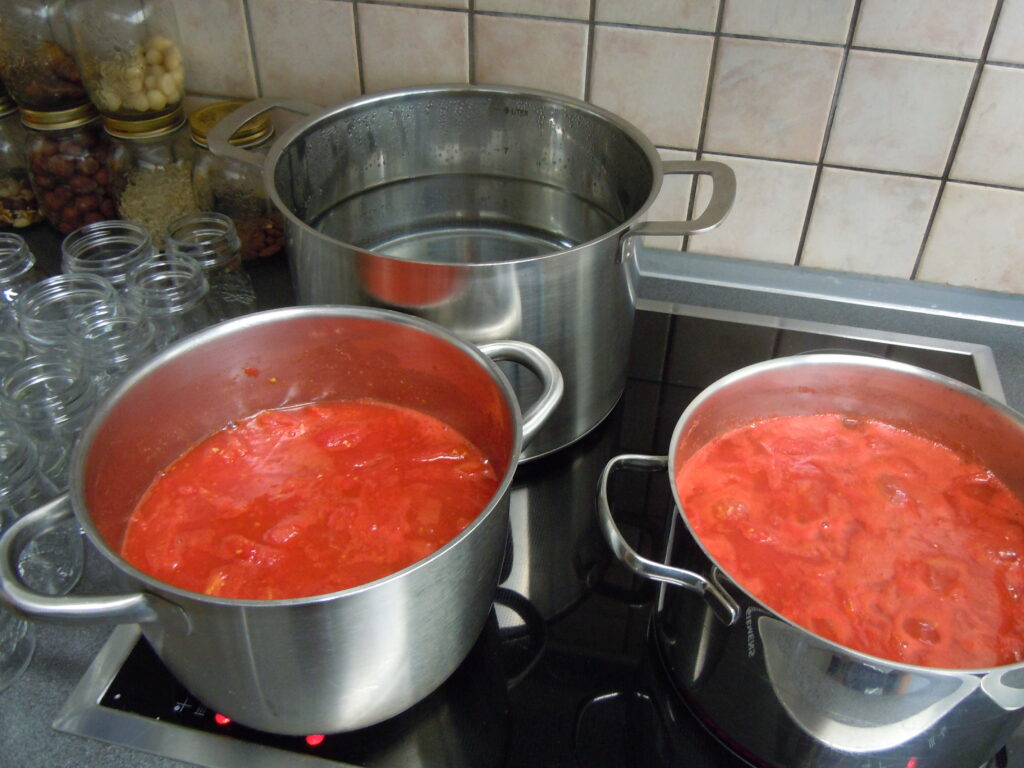
How to process the tomato sauce using a boiling hot water bath
Jar the tomato sauce
- When the sauce is ready, keep it simmering on a very low heat while you fill the boiling hot jars with the help of a sterilised ladle and funnel. Fill them to within 2 cm (about an inch) from the brim. Don’t fill more jars than will fit in the pan. Do them in batches if necessary.
- Screw the caps firmly onto the jars as you fill them, and then lower them carefully into the pan of boiling water.
- Once all the jars are in the pan, make sure the water level is at least 2 – 3 cm above the caps and that the water is boiling.
Sterilise the jars of tomato sauce
- Boil the jars of tomato sauce for 20 minutes, occasionally checking the water level. If you need to top up, make sure that the water you add is boiling. It’s best to boil them with the lid on the pan. There are three reasons for doing this: firstly, you’ll reach the highest possible temperature in the quickest time; secondly, you’ll save electricity/gas because you can turn the heat right down to low and the water will still be boiling; thirdly, there will be much less evaporation, and you won’t risk the water level going down and tops of the jars emerging.
Cooling phase
- After 20 minutes, turn off the heat under the pan, but leave the jars in the water for at least another 20 minutes, preferably until the water has cooled down completely.
- As the jars cool down, you’ll hear the lids clicking – this means a vacuum has formed and they are sealed.
- Remove the jars from the pan using a jar lifter and place them on a clean kitchen cloth.
How to check the seals
- When the jars have cooled down completely, wipe them down with a damp cloth.
- Check the seals by pressing down on the lids with your thumb or fingers. If the centre of the cap is down and doesn’t move when you press down on it, it’s sealed.
Storage
- Put any jars that didn’t seal properly in the fridge and use them within a week. The contents are perfectly fine to eat because they have been sterilised, but they will only have the same fridge life as an opened jar.
- Label your jars with the content (rustic or passata, type of tomatoes used, etc) and the date. Store them in a cool dry place, away from direct sunlight.
How long will the jars of tomato sauce last?
Jars of tomato sauce processed in this way will last for a year. Once you have opened a jar, refrigerate it and use it within 3 – 4 days.
Final precautions
- Before opening a jar, check that the seal is intact by pressing down on the lid with your fingers. It should be firmly sucked down and should not click when you press on it.
- The lid should be tightly screwed on and make a loud click as you unscrew it.
- The tomato sauce should look and smell fresh.
- The inside of the lid should not be rusty or have mould on it.
Your jar of tomato sauce should comply with ALL of the above points. If it doesn’t, throw it out!
I hope you found this post on how to make and jar your own tomato sauce useful! Maybe you’d like to try out my recipe for fresh tomato pasta sauce, using just this basic tomato sauce, a clove of crushed garlic, extra virgin olive oil and a little unrefined sea salt. Simplicity – the Italian way!
If you have any questions, please don’t hesitate to ask!
If you found this post useful, please give it a 5-star rating and leave a comment below. This is a great way to support me, and it’s helpful to other users, too. If you make this tomato sauce and you’re as enthusiastic as we are about jarring homemade tomato sauce the Italian way, let me know! I’d love to hear from you!
Don’t forget to check out my post for fresh tomato pasta sauce, where you’ll find out how to transform your basic tomato sauce into a sensational pasta dish using simple seasonings – Learn how to do it the Italian way!
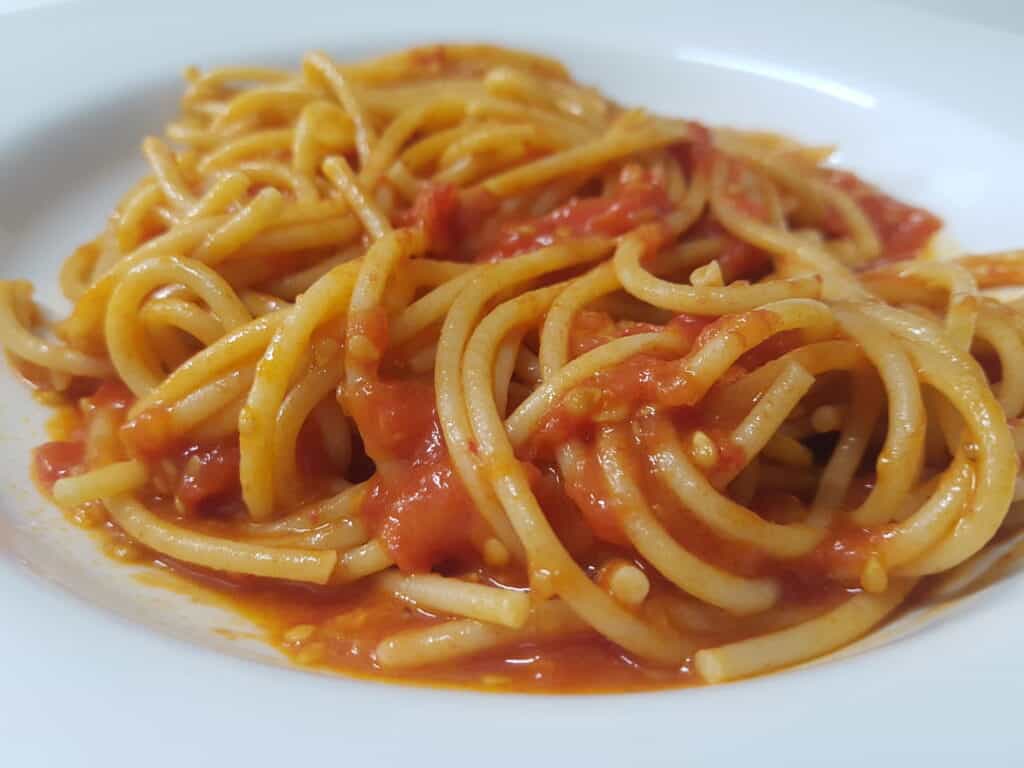
While you’re here on Vegan Hot Stuff, maybe you’d also like to take a look at some other popular recipes!
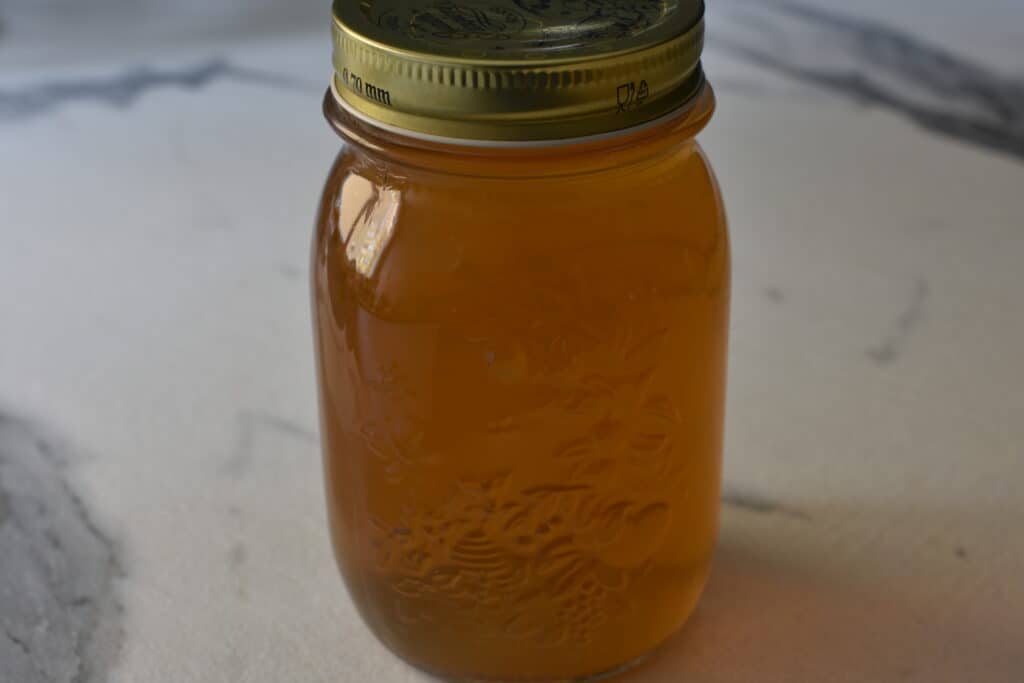
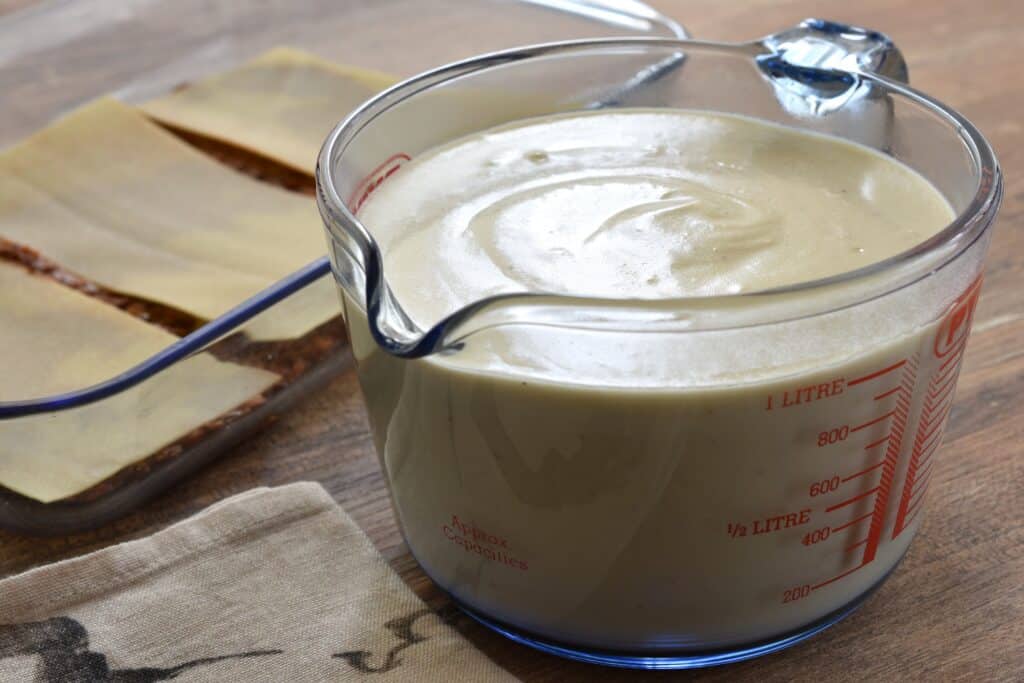

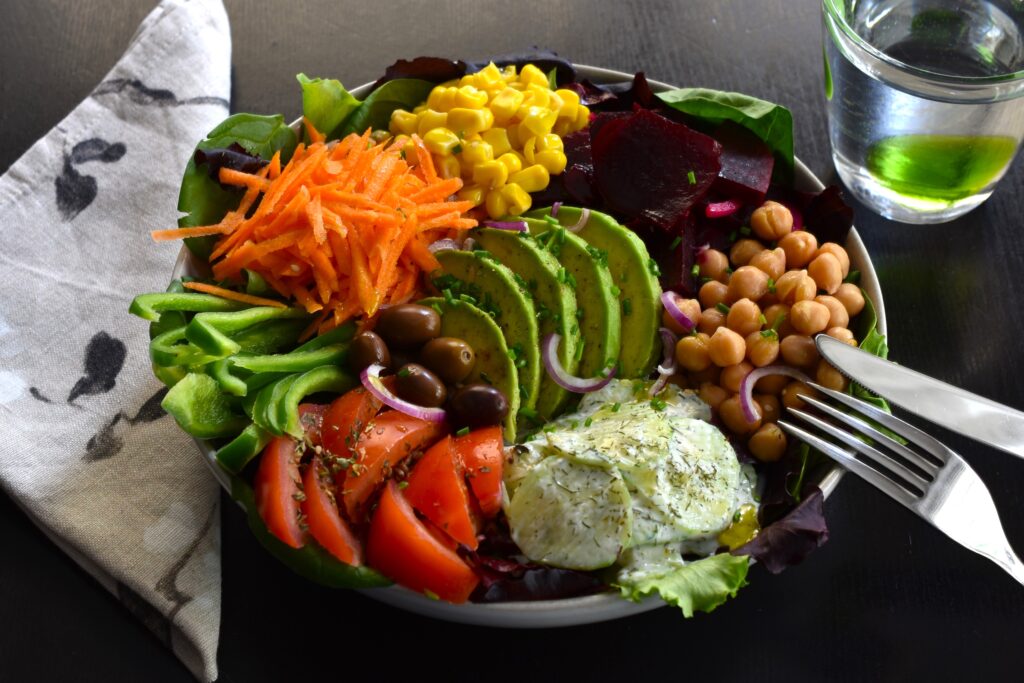
Would you like to receive my recipes as soon as I publish them? Subscribe below!


